2014 NISSAN TEANA lock
[x] Cancel search: lockPage 2404 of 4801
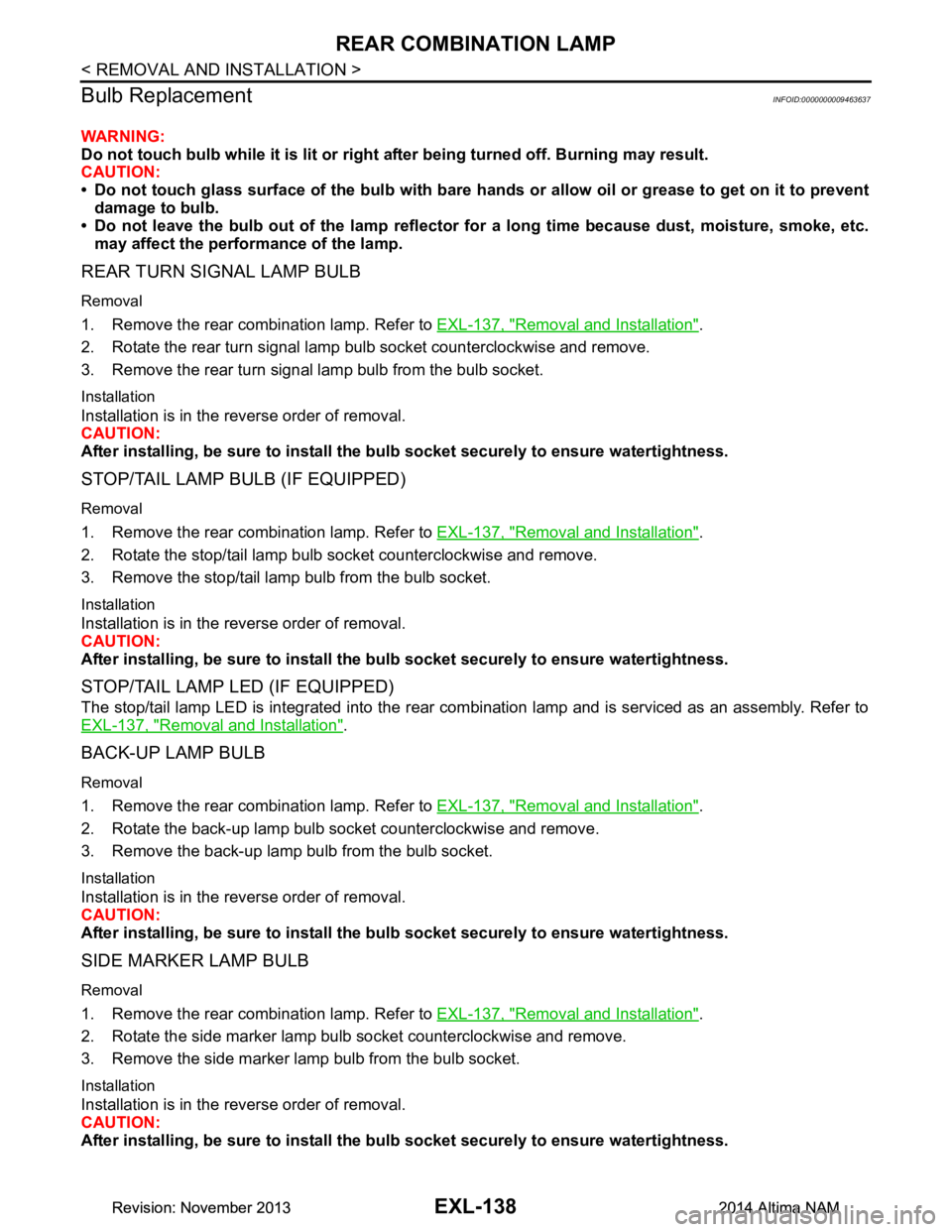
EXL-138
< REMOVAL AND INSTALLATION >
REAR COMBINATION LAMP
Bulb Replacement
INFOID:0000000009463637
WARNING:
Do not touch bulb while it is lit or right after being turned off. Burning may result.
CAUTION:
• Do not touch glass surface of the bulb with bare hands or allow oil or grease to get on it to prevent
damage to bulb.
• Do not leave the bulb out of the lamp reflector fo r a long time because dust, moisture, smoke, etc.
may affect the performance of the lamp.
REAR TURN SIGNAL LAMP BULB
Removal
1. Remove the rear combination lamp. Refer to EXL-137, "Removal and Installation".
2. Rotate the rear turn signal lamp bulb socket counterclockwise and remove.
3. Remove the rear turn signal lamp bulb from the bulb socket.
Installation
Installation is in the reverse order of removal.
CAUTION:
After installing, be sure to install the bu lb socket securely to ensure watertightness.
STOP/TAIL LAMP BULB (IF EQUIPPED)
Removal
1. Remove the rear combination lamp. Refer to EXL-137, "Removal and Installation".
2. Rotate the stop/tail lamp bulb socket counterclockwise and remove.
3. Remove the stop/tail lamp bulb from the bulb socket.
Installation
Installation is in the reverse order of removal.
CAUTION:
After installing, be sure to install the bu lb socket securely to ensure watertightness.
STOP/TAIL LAMP LED (IF EQUIPPED)
The stop/tail lamp LED is integrated into the rear combination lamp and is serviced as an assembly. Refer to
EXL-137, "Removal and Installation"
.
BACK-UP LAMP BULB
Removal
1. Remove the rear combination lamp. Refer to EXL-137, "Removal and Installation".
2. Rotate the back-up lamp bulb socket counterclockwise and remove.
3. Remove the back-up lamp bulb from the bulb socket.
Installation
Installation is in the reverse order of removal.
CAUTION:
After installing, be sure to install the bu lb socket securely to ensure watertightness.
SIDE MARKER LAMP BULB
Removal
1. Remove the rear combination lamp. Refer to EXL-137, "Removal and Installation".
2. Rotate the side marker lamp bulb socket counterclockwise and remove.
3. Remove the side marker lamp bulb from the bulb socket.
Installation
Installation is in the reverse order of removal.
CAUTION:
After installing, be sure to install the bu lb socket securely to ensure watertightness.
Revision: November 20132014 Altima NAMRevision: November 20132014 Altima NAM
Page 2405 of 4801
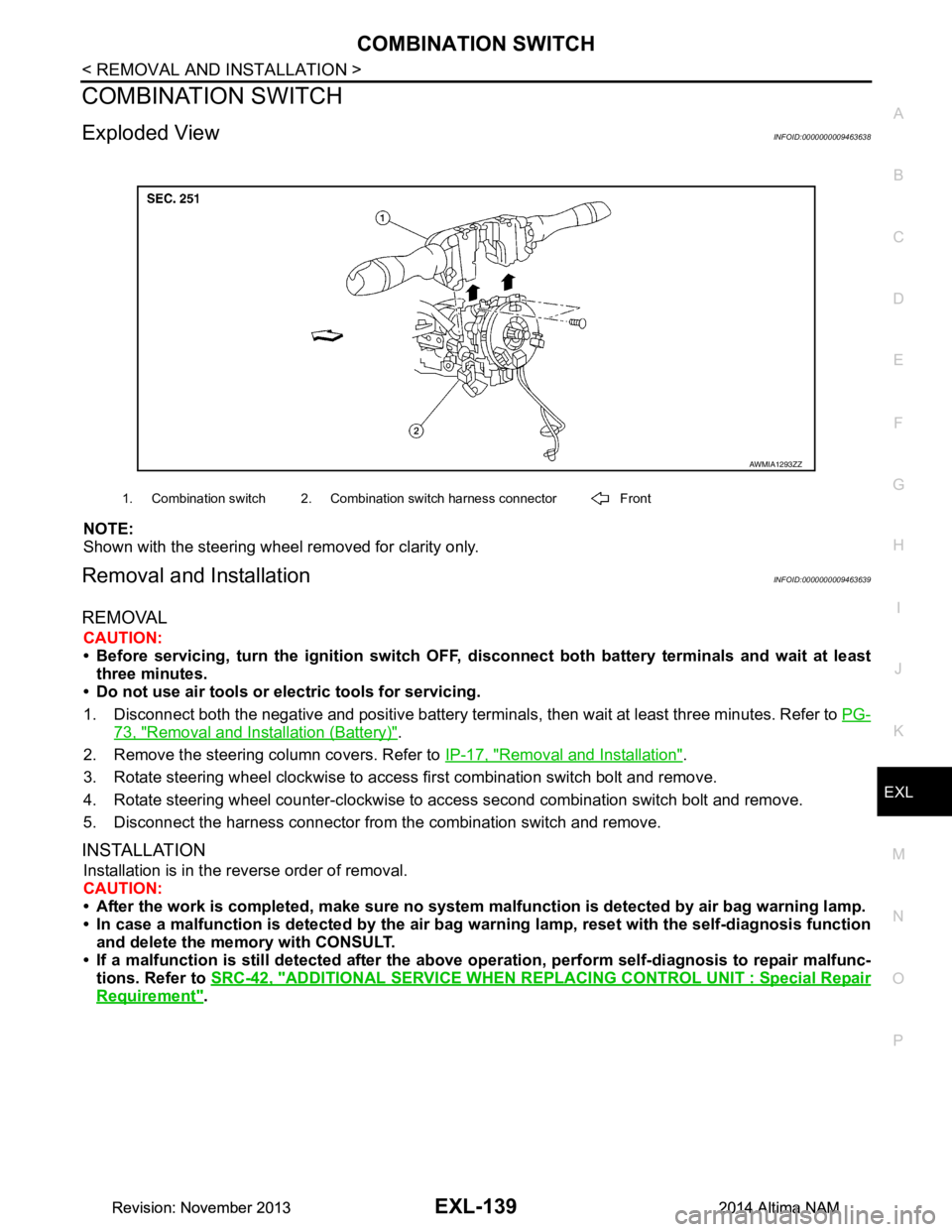
COMBINATION SWITCHEXL-139
< REMOVAL AND INSTALLATION >
C
D E
F
G H
I
J
K
M A
B
EXL
N
O P
COMBINATION SWITCH
Exploded ViewINFOID:0000000009463638
NOTE:
Shown with the steering wheel removed for clarity only.
Removal and InstallationINFOID:0000000009463639
REMOVAL
CAUTION:
• Before servicing, turn the ignition switch OFF, disconnect both battery terminals and wait at least
three minutes.
• Do not use air tools or electric tools for servicing.
1. Disconnect both the negative and positive battery terminal s, then wait at least three minutes. Refer to PG-
73, "Removal and Installation (Battery)".
2. Remove the steering column covers. Refer to IP-17, "Removal and Installation"
.
3. Rotate steering wheel clockwise to access first combination switch bolt and remove.
4. Rotate steering wheel counter-clockwise to access second combination switch bolt and remove.
5. Disconnect the harness connector from the combination switch and remove.
INSTALLATION
Installation is in the reverse order of removal.
CAUTION:
• After the work is completed, make sure no system malfunction is detected by air bag warning lamp.
• In case a malfunction is detected by the air bag wa rning lamp, reset with the self-diagnosis function
and delete the memory with CONSULT.
• If a malfunction is still detected after the above operation, perform self-diagnosis to repair malfunc-
tions. Refer to SRC-42, "ADDITIONAL SERVICE WHEN RE PLACING CONTROL UNIT : Special Repair
Requirement".
AWMIA1293ZZ
1. Combination switch 2. Combination switch harness connector Front
Revision: November 20132014 Altima NAMRevision: November 20132014 Altima NAM
Page 2408 of 4801
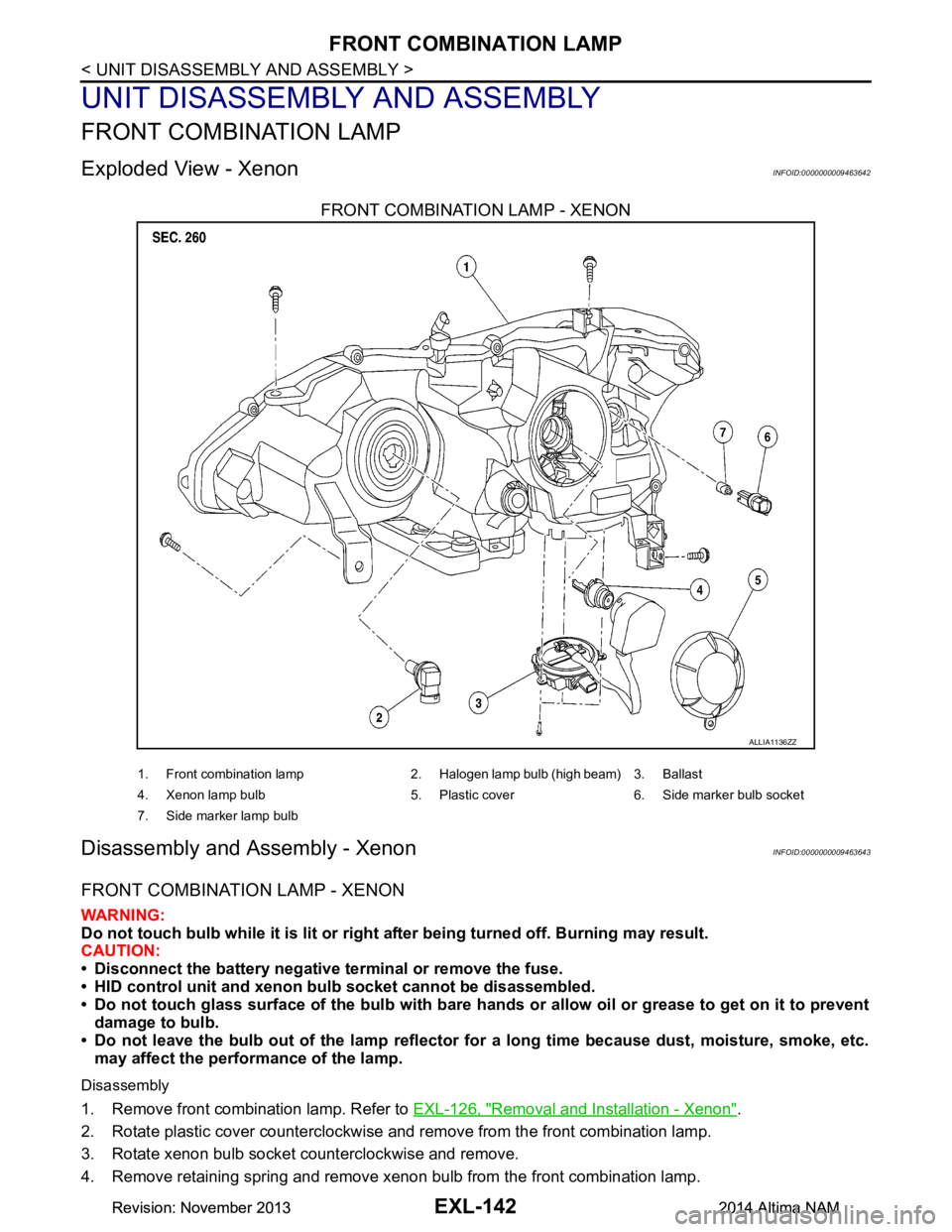
EXL-142
< UNIT DISASSEMBLY AND ASSEMBLY >
FRONT COMBINATION LAMP
UNIT DISASSEMBLY AND ASSEMBLY
FRONT COMBINATION LAMP
Exploded View - XenonINFOID:0000000009463642
FRONT COMBINATION LAMP - XENON
Disassembly and Assembly - XenonINFOID:0000000009463643
FRONT COMBINATION LAMP - XENON
WARNING:
Do not touch bulb while it is lit or right after being turned off. Burning may result.
CAUTION:
• Disconnect the battery negative terminal or remove the fuse.
• HID control unit and xenon bu lb socket cannot be disassembled.
• Do not touch glass surface of the bulb with bare hands or allow oil or grease to get on it to prevent
damage to bulb.
• Do not leave the bulb out of the lamp reflector fo r a long time because dust, moisture, smoke, etc.
may affect the performance of the lamp.
Disassembly
1. Remove front combination lamp. Refer to EXL-126, "Removal and Installation - Xenon".
2. Rotate plastic cover counterclockwise and remove from the front combination lamp.
3. Rotate xenon bulb socket counterclockwise and remove.
4. Remove retaining spring and remove xenon bulb from the front combination lamp.
ALLIA1136ZZ
1. Front combination lamp 2. Halogen lamp bulb (high beam) 3. Ballast
4. Xenon lamp bulb 5. Plastic cover 6. Side marker bulb socket
7. Side marker lamp bulb
Revision: November 20132014 Altima NAMRevision: November 20132014 Altima NAM
Page 2409 of 4801
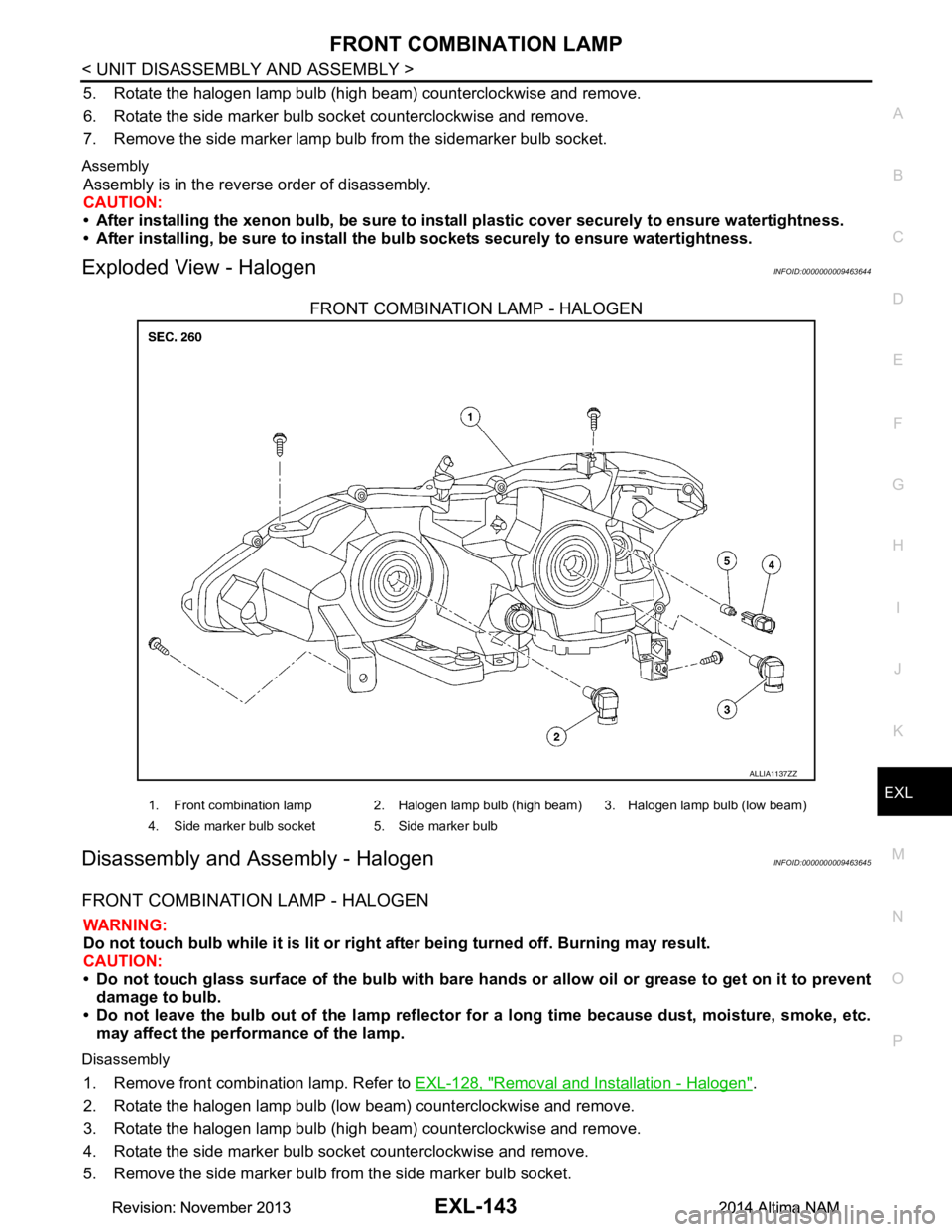
FRONT COMBINATION LAMPEXL-143
< UNIT DISASSEMBLY AND ASSEMBLY >
C
D E
F
G H
I
J
K
M A
B
EXL
N
O P
5. Rotate the halogen lamp bulb (high beam) counterclockwise and remove.
6. Rotate the side marker bulb socket counterclockwise and remove.
7. Remove the side marker lamp bulb from the sidemarker bulb socket.
Assembly
Assembly is in the reverse order of disassembly.
CAUTION:
• After installing the xenon bulb, be sure to install plastic cover securely to ensure watertightness.
• After installing, be sure to install the bulb sockets securely to ensure watertightness.
Exploded View - HalogenINFOID:0000000009463644
FRONT COMBINATION LAMP - HALOGEN
Disassembly and Assembly - HalogenINFOID:0000000009463645
FRONT COMBINATION LAMP - HALOGEN
WARNING:
Do not touch bulb while it is lit or right after being turned off. Burning may result.
CAUTION:
• Do not touch glass surface of the bulb with bare hand s or allow oil or grease to get on it to prevent
damage to bulb.
• Do not leave the bulb out of the lamp reflector fo r a long time because dust, moisture, smoke, etc.
may affect the performance of the lamp.
Disassembly
1. Remove front combination lamp. Refer to EXL-128, "Removal and Installation - Halogen".
2. Rotate the halogen lamp bulb (low beam) counterclockwise and remove.
3. Rotate the halogen lamp bulb (high beam) counterclockwise and remove.
4. Rotate the side marker bulb socket counterclockwise and remove.
5. Remove the side marker bulb from the side marker bulb socket.
ALLIA1137ZZ
1. Front combination lamp 2. Halogen lamp bulb (high beam) 3. Halogen lamp bulb (low beam)
4. Side marker bulb socket 5. Side marker bulb
Revision: November 20132014 Altima NAMRevision: November 20132014 Altima NAM
Page 2411 of 4801
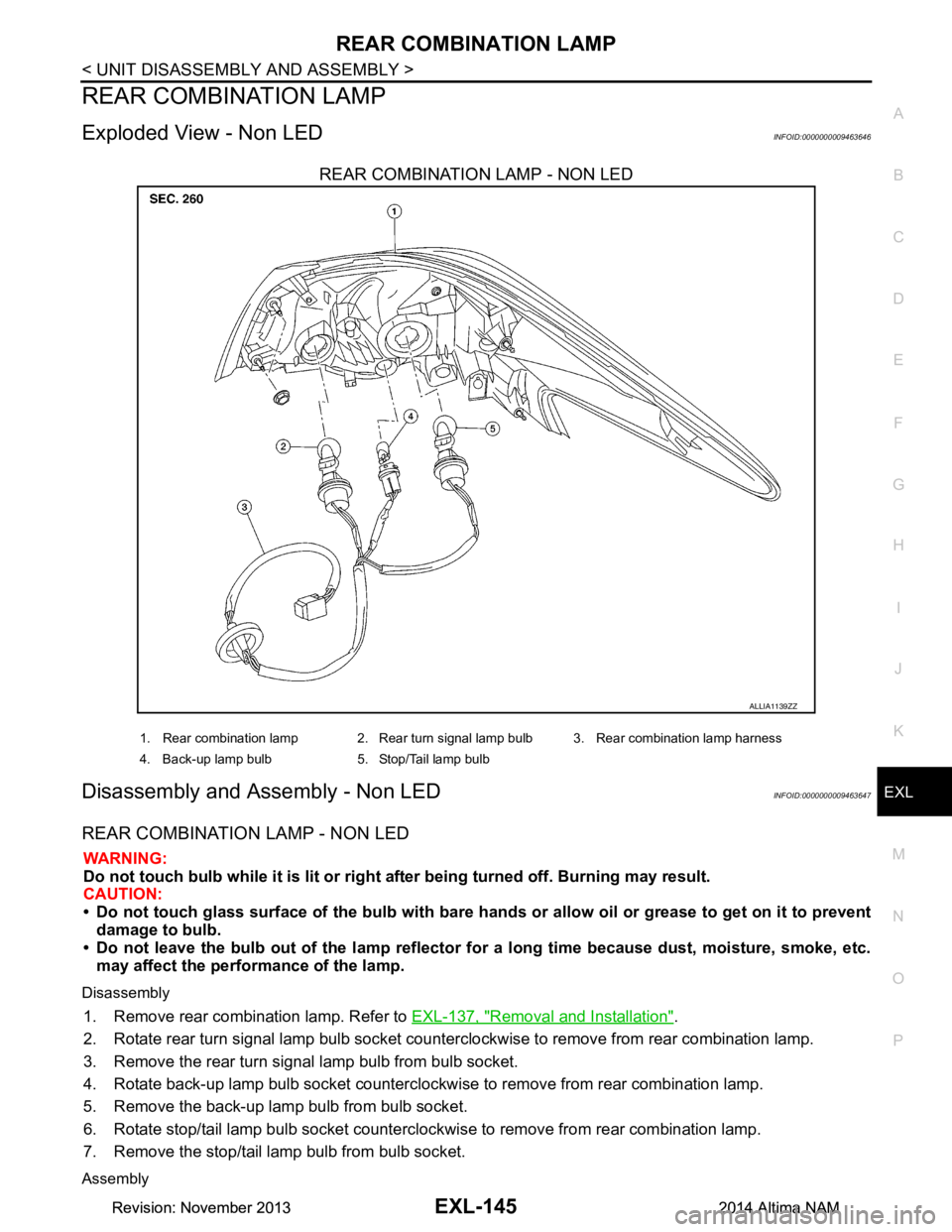
REAR COMBINATION LAMPEXL-145
< UNIT DISASSEMBLY AND ASSEMBLY >
C
D E
F
G H
I
J
K
M A
B
EXL
N
O P
REAR COMBINATION LAMP
Exploded View - Non LEDINFOID:0000000009463646
REAR COMBINATION LAMP - NON LED
Disassembly and Assembly - Non LEDINFOID:0000000009463647
REAR COMBINATION LAMP - NON LED
WARNING:
Do not touch bulb while it is lit or right after being turned off. Burning may result.
CAUTION:
• Do not touch glass surface of the bulb with bare hand s or allow oil or grease to get on it to prevent
damage to bulb.
• Do not leave the bulb out of the lamp reflector fo r a long time because dust, moisture, smoke, etc.
may affect the performance of the lamp.
Disassembly
1. Remove rear combination lamp. Refer to EXL-137, "Removal and Installation".
2. Rotate rear turn signal lamp bulb socket counterclockwise to remove from rear combination lamp.
3. Remove the rear turn signal lamp bulb from bulb socket.
4. Rotate back-up lamp bulb socket counterclockwise to remove from rear combination lamp.
5. Remove the back-up lamp bulb from bulb socket.
6. Rotate stop/tail lamp bulb socket counterclockwise to remove from rear combination lamp.
7. Remove the stop/tail lamp bulb from bulb socket.
Assembly
ALLIA1139ZZ
1. Rear combination lamp 2. Rear turn signal lamp bulb 3. Rear combination lamp harness
4. Back-up lamp bulb 5. Stop/Tail lamp bulb
Revision: November 20132014 Altima NAMRevision: November 20132014 Altima NAM
Page 2412 of 4801
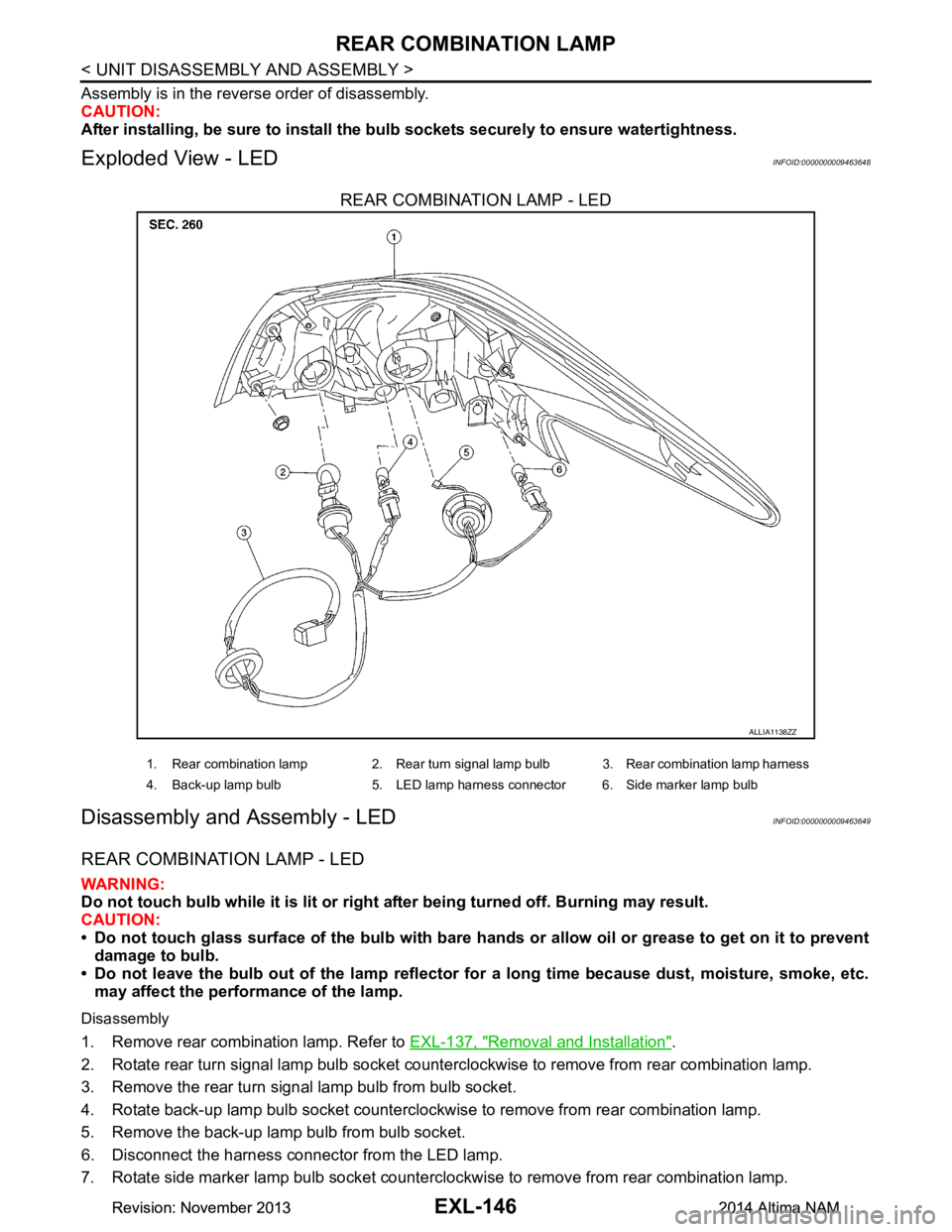
EXL-146
< UNIT DISASSEMBLY AND ASSEMBLY >
REAR COMBINATION LAMP
Assembly is in the reverse order of disassembly.
CAUTION:
After installing, be sure to install the bu lb sockets securely to ensure watertightness.
Exploded View - LED INFOID:0000000009463648
REAR COMBINATION LAMP - LED
Disassembly and Assembly - LEDINFOID:0000000009463649
REAR COMBINATION LAMP - LED
WARNING:
Do not touch bulb while it is lit or right after being turned off. Burning may result.
CAUTION:
• Do not touch glass surface of the bulb with bare hands or allow oil or grease to get on it to prevent
damage to bulb.
• Do not leave the bulb out of the lamp reflector fo r a long time because dust, moisture, smoke, etc.
may affect the performance of the lamp.
Disassembly
1. Remove rear combination lamp. Refer to EXL-137, "Removal and Installation".
2. Rotate rear turn signal lamp bulb socket counterclockwise to remove from rear combination lamp.
3. Remove the rear turn signal lamp bulb from bulb socket.
4. Rotate back-up lamp bulb socket counterclockwise to remove from rear combination lamp.
5. Remove the back-up lamp bulb from bulb socket.
6. Disconnect the harness connec tor from the LED lamp.
7. Rotate side marker lamp bulb socket counterclockwise to remove from rear combination lamp.
ALLIA1138ZZ
1. Rear combination lamp 2. Rear turn signal lamp bulb 3. Rear combination lamp harness
4. Back-up lamp bulb 5. LED lamp harness connector 6. Side marker lamp bulb
Revision: November 20132014 Altima NAMRevision: November 20132014 Altima NAM
Page 2424 of 4801

EXT-10
< PERIODIC MAINTENANCE >
SQUEAK AND RATTLE TROUBLE DIAGNOSES
PERIODIC MAINTENANCE
SQUEAK AND RATTLE TROUBLE DIAGNOSES
Work FlowINFOID:0000000009895307
CUSTOMER INTERVIEW
Interview the customer if possible, to determine the conditions that exist when the noise occurs. Use the Diag-
nostic Worksheet during the interview to document the facts and conditions when the noise occurs and any
customer's comments; refer to EXT-14, "Diagnostic Worksheet"
. This information is necessary to duplicate the
conditions that exist when the noise occurs.
• The customer may not be able to provide a detailed description or the location of the noise. Attempt to obtain
all the facts and conditions that exist w hen the noise occurs (or does not occur).
• If there is more than one noise in the vehicle, be sure to diagnose and repair the noise that the customer is
concerned about. This can be accomplished by test driving the vehicle with the customer.
• After identifying the type of noise, isolate the noise in terms of its characteristics. The noise characteristics
are provided so the customer, service adviser and technician are all speaking the same language when
defining the noise.
• Squeak —(Like tennis shoes on a clean floor) Squeak characteristics include the light contact/fast movement/brought on by road conditions/hard surfaces
= higher pitch noise/softer surfaces = lower pitch noises/edge to surface = chirping.
• Creak—(Like walking on an old wooden floor) Creak characteristics include firm contact/slow mo vement/twisting with a rotational movement/pitch depen-
dent on materials/often brought on by activity.
• Rattle—(Like shaking a baby rattle) Rattle characteristics include the fast repeated contac t/vibration or similar movement/loose parts/missing
clip or fastener/incorrect clearance.
• Knock —(Like a knock on a door) Knock characteristics include hollow sounding/someti mes repeating/often brought on by driver action.
• Tick—(Like a clock second hand) Tick characteristics include gentle contacting of light materials/loose components/can be caused by driver
action or road conditions.
• Thump—(Heavy, muffled knock noise)
Thump characteristics include softer k nock/dead sound often brought on by activity.
• Buzz—(Like a bumble bee) Buzz characteristics include hi gh frequency rattle/firm contact.
• Often the degree of acceptable noise level will vary depending upon the person. A noise that you may judge
as acceptable may be very irritating to the customer.
• Weather conditions, especially humidity and temperat ure, may have a great effect on noise level.
DUPLICATE THE NOISE AND TEST DRIVE
SBT842
Revision: November 20132014 Altima NAM
Page 2425 of 4801
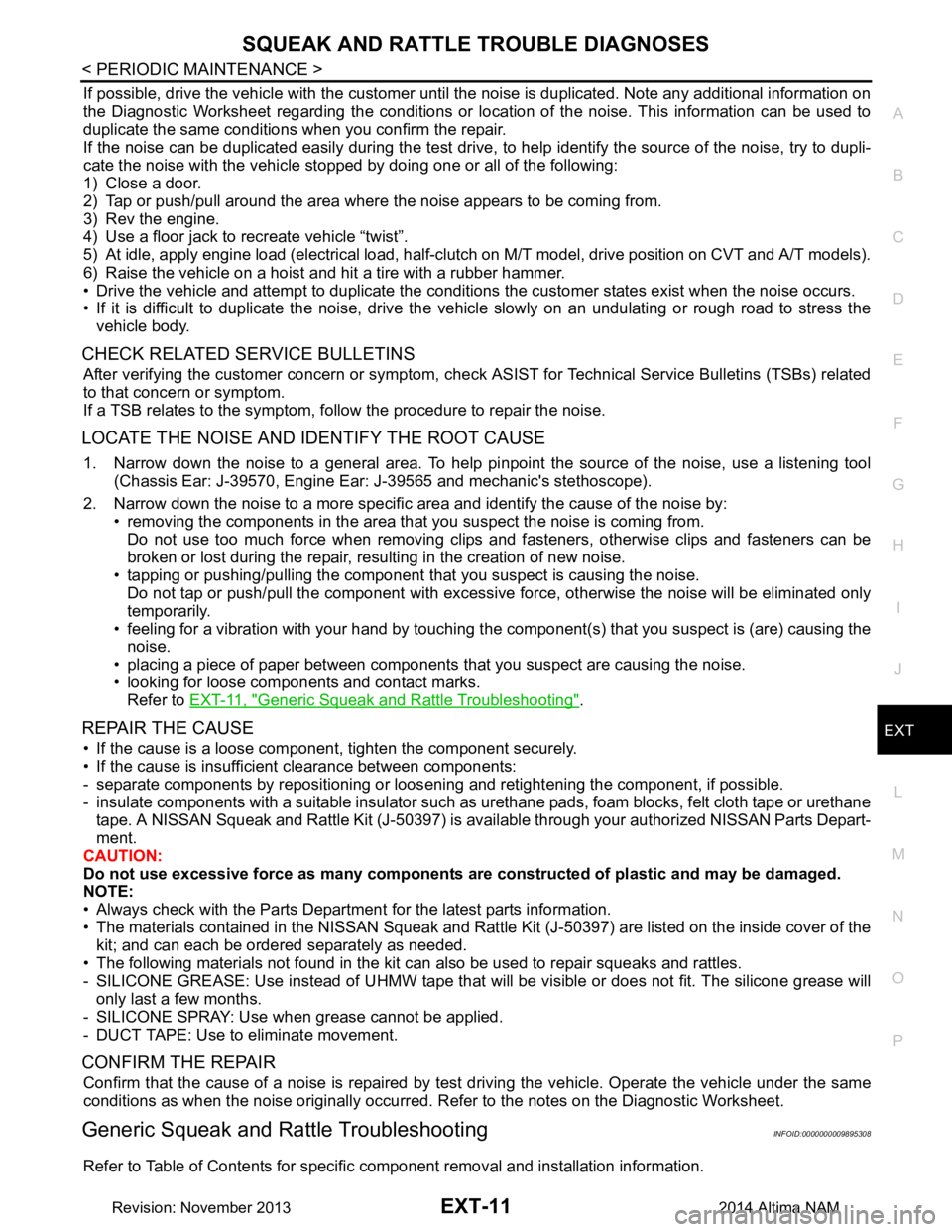
SQUEAK AND RATTLE TROUBLE DIAGNOSESEXT-11
< PERIODIC MAINTENANCE >
C
D E
F
G H
I
J
L
M A
B
EXT
N
O P
If possible, drive the vehicle with the customer until the noise is duplicated. Note any additional information on
the Diagnostic Worksheet regarding the conditions or lo cation of the noise. This information can be used to
duplicate the same conditions when you confirm the repair.
If the noise can be duplicated easily during the test drive, to help identify the source of the noise, try to dupli-
cate the noise with the vehicle stopped by doing one or all of the following:
1) Close a door.
2) Tap or push/pull around the area where the noise appears to be coming from.
3) Rev the engine.
4) Use a floor jack to recreate vehicle “twist”.
5) At idle, apply engine load (electrical load, half-clutch on M/T model, drive position on CVT and A/T models).
6) Raise the vehicle on a hoist and hit a tire with a rubber hammer.
• Drive the vehicle and attempt to duplicate the conditions the customer states exist when the noise occurs.
• If it is difficult to duplicate the noise, drive the vehicle slowly on an undulating or rough road to stress the
vehicle body.
CHECK RELATED SERVICE BULLETINS
After verifying the customer concern or symptom, che ck ASIST for Technical Service Bulletins (TSBs) related
to that concern or symptom.
If a TSB relates to the symptom, follow the procedure to repair the noise.
LOCATE THE NOISE AND IDENTIFY THE ROOT CAUSE
1. Narrow down the noise to a general area. To help pi npoint the source of the noise, use a listening tool
(Chassis Ear: J-39570, Engine Ear: J-39565 and mechanic's stethoscope).
2. Narrow down the noise to a more specific area and identify the cause of the noise by: • removing the components in the area that you suspect the noise is coming from.Do not use too much force when removing clips and fasteners, otherwise clips and fasteners can be
broken or lost during the repair, resulting in the creation of new noise.
• tapping or pushing/pulling the component that you suspect is causing the noise.
Do not tap or push/pull the component with excessive force, otherwise the noise will be eliminated only
temporarily.
• feeling for a vibration with your hand by touching the component(s) that you suspect is (are) causing the
noise.
• placing a piece of paper between components that you suspect are causing the noise.
• looking for loose components and contact marks. Refer to EXT-11, "Generic Squeak and Rattle Troubleshooting"
.
REPAIR THE CAUSE
• If the cause is a loose component, tighten the component securely.
• If the cause is insufficient clearance between components:
- separate components by repositioning or loos ening and retightening the component, if possible.
- insulate components with a suitable insulator such as urethane pads, foam blocks, felt cloth tape or urethane
tape. A NISSAN Squeak and Rattle Kit (J-50397) is av ailable through your authorized NISSAN Parts Depart-
ment.
CAUTION:
Do not use excessive force as many components are constructed of plastic and may be damaged.
NOTE:
• Always check with the Parts Department for the latest parts information.
• The materials contained in the NISSAN Squeak and Rattle Kit (J-50397) are listed on the inside cover of the
kit; and can each be ordered separately as needed.
• The following materials not found in the kit can also be used to repair squeaks and rattles.
- SILICONE GREASE: Use instead of UHMW tape that will be visible or does not fit. The silicone grease will
only last a few months.
- SILICONE SPRAY: Use when grease cannot be applied.
- DUCT TAPE: Use to eliminate movement.
CONFIRM THE REPAIR
Confirm that the cause of a noise is repaired by test driving the vehicle. Operate the vehicle under the same
conditions as when the noise originally occurred. Refer to the notes on the Diagnostic Worksheet.
Generic Squeak and Rattle TroubleshootingINFOID:0000000009895308
Refer to Table of Contents for specific component removal and installation information.
Revision: November 20132014 Altima NAM